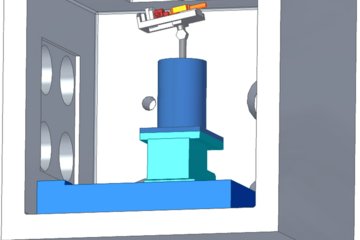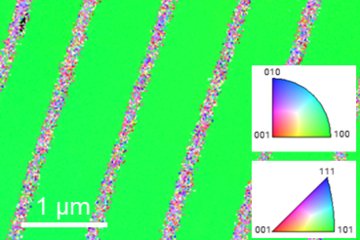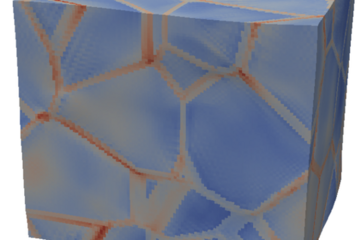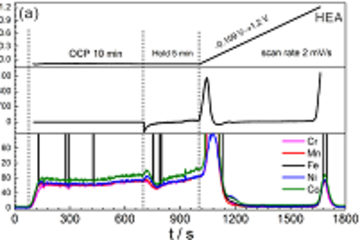All genres
41.
Journal Article
Numerically robust spectral methods for crystal plasticity simulations of heterogeneous materials. International Journal of Plasticity 66, pp. 31 - 45 (2015)
42.
Journal Article
Linking atomistic, kinetic Monte Carlo and crystal plasticity simulations of single-crystal tungsten strength. GAMM-Mitteilungen 38 (2), pp. 213 - 227 (2015)
43.
Journal Article
Integrated experimental–simulation analysis of stress and strain partitioning in multiphase alloys. Acta Materialia 81, pp. 386 - 400 (2014)
44.
Journal Article
Strain localization and damage in dual phase steels investigated by coupled in-situ deformation experiments and crystal plasticity simulations. International Journal of Plasticity 63, pp. 198 - 210 (2014)
45.
Journal Article
In situ observation of collective grain-scale mechanics in Mg and Mg-rare earth alloys. Acta Materialia 80, pp. 77 - 93 (2014)
46.
Journal Article
A spectral method solution to crystal elasto-viscoplasticity at finite strains. International Journal of Plasticity 46, pp. 37 - 53 (2013)
47.
Book Chapter
Spectral Solvers for Crystal Plasticity and Multi-physics Simulations. In: Handbook of Mechanics of Materials, pp. 1347 - 1372 (Eds. Hsueh, C.-H.; Schmauder, S.; Chen, C.-S.; Chawla, K. K.; Chawla, N. et al.). Springer, Singapore (2019)
48.
Book Chapter
Crystal Plasticity Modeling. In: Microstructural Design of Advanced Engineering Materials, 3, pp. 41 - 57 (Ed. Molodov, D. A.). Wiley-VCH Verlag GmbH Co. KGaA, Weinheim (2013)
49.
Conference Paper
Coupled Experimental-Numerical Analysis of Strain Partitioning in Metallic Microstructures: The Importance of Considering the 3D Morphology. In: Session 1.3a, Strain Measurement at the Microscale 1, pp. 1 - 2. BSSM 12th International Conference on Advances in Experimental Mechanics, Sheffield, UK, August 29, 2017. (2017)
50.
Conference Paper
DAMASK: The Düsseldorf Advanced MAterial Simulation Kit for studying crystal plasticity using an FE based or a spectral numerical solver. IUTAM Symposium on Linking Scales in Computations: From Microstructure to Macro-scale Properties, Pensacola, FL, USA, May 17, 2011 - May 19, 2011. IUTAM Symposium on Linking Scales in Computations: From Microstructure to Macro-scale Properties, (2012)
51.
Talk
Challenges of Developing and Scaling up DAMASK, a Unified Large-strain Multi-physics Crystal Plasticity Simulation Software. TMS - Algorithm Development in Materials Science and Engineering, Orlando, FL, USA (2024)
52.
Talk
Using DAMASK as material model in MSC Marc. Marc Community Meeting, online (2024)
53.
Talk
Multi-Field Modelling of Crystal Plasticity and Damage. CMCS 2023, Eindhoven, Netherlands (2023)
54.
Talk
DAMASK: Challenges in collaborative development and outlook. deRSE23 - Conference for Research Software Engineering in Germany, Paderborn, Germany (2023)
55.
Talk
DAMASK: the Düsseldorf Advanced MAterial Simulation Kit for studying multi-field crystal plasticity phenomena. Seminar at Harbin Institute of Technology, online
, Shenzhen, China (2023)
56.
Talk
Modelling Coupled Chemo-Mechanical fracture in DAMASK. M2i conference, “Meeting Materials”
, Noordwijkerhout, The Netherlands (2022)
57.
Talk
Inverse design of dual-phase steel microstructures using generative machine learning model and Bayesian optimization. Working Group Microstructural Mechanics, Deutsche Gesellschaft für Materialkunde e.V., Applications of Machine Learning for Mechanical Behavior of Materials, Online (2022)
58.
Talk
DAMASK: the Düsseldorf Advanced MAterial Simulation Kit for studying multi-field crystal plasticity phenomena. Seminar, Engineering Science Department at the University of Oxford, virtual, Oxford, UK (2021)
59.
Talk
Using machine learning and crystal plasticity simulation to design damage resistant dual phase steels. Webinar: Metal Plasticity Seminar - Artificial Intelligence, Machine Learning and Big Data in Metal Plasticity, Leuven, Belgium (2021)
60.
Talk
Multiphysics simulations in DAMASK. Euromat 2021, Virtual (2021)











